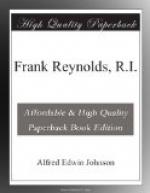Other drawings in the same series, depicting other examples of the strange freaks of humanity by whom the British public delights to be entertained, afford good examples of the innate humour of Frank Reynolds’ art. There is often little that is actually comic in the situations depicted, yet each is instinct with humour. It is the triumph of Reynolds’ comic art that he can snare, on the wing as it were, humour that is too elusive and nimble for one of slower perception and heavier hand.
[Illustration: VIVE L’ARMEE From “Paris and Some Parisians"]
“Art and the Man” was a series of drawings in the vein of farce rather than of comedy. The intention was to depict various types of artists rather as fancy might paint them than as they really are. The “Marine Artist,” for example, with his canvas slung from davits and the entire furniture of his studio of extremely nautical design, was a purely fanciful conception. The “Pot-Boiler,” spending his days in painting one solitary subject over and over again ad infinitum, comes nearer to life, though his portrait again is an exaggerated fancy rather than a study from life. One feels, nevertheless, that if there be indeed such an individual as the pot-boiler in existence, this, and no other, must be his outward guise.
The drawings entitled “Dinners with Shakespeare,” to which allusion has already been made, gave scope for a very varied range of character studies. Meal-time is a happy moment at which to catch human nature unawares, and the artist made the most of his opportunities. They add to the debt which the historians of contemporary manners will owe to Reynolds in the future, for as a sidelight on social habits of the present day these pictures of the dinner-table will be instructive. The very triteness of their theme gives them their interest.
[Illustration: “GAZED ON HAROLD” From “Paris and Some Parisians"]
[Illustration: FROM A PARIS SKETCH-BOOK]




